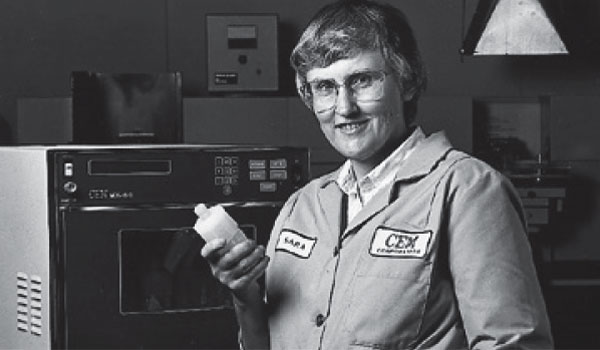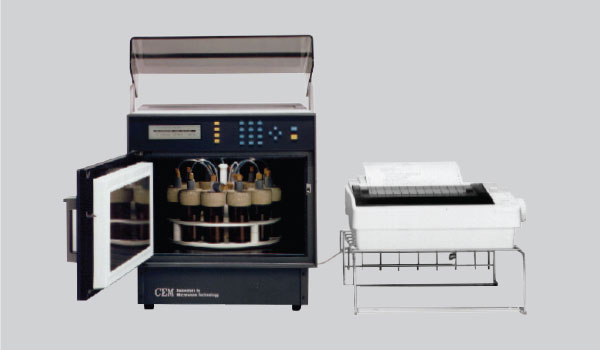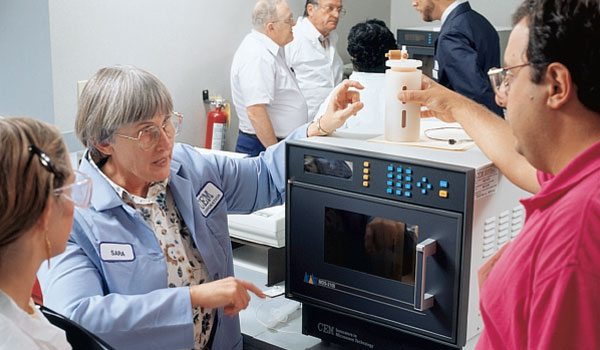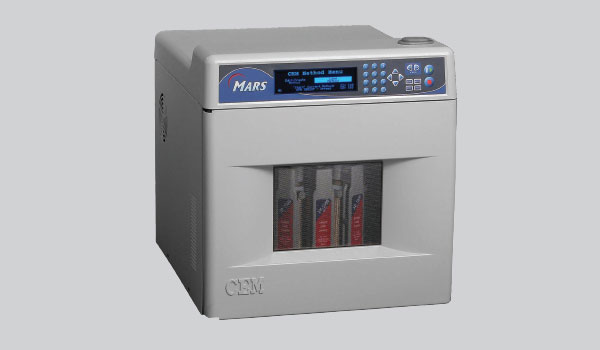History of Microwave Digestion

The company you keep says a lot about your organization. From the very beginning of our mission to develop a
microwave digestion system CEM has worked hand-in-hand with some of the world's most influential organizations.
In 1985 CEM and the National Bureau of Standards (NBS), which is now NIST, began working together to develop a safe, laboratory-grade, microwave digestion system to help labs speed up the sample prep bottleneck of metals analysis. The MDS 81D was launched in late 1986 as a result and in 1987 the NBS and CEM jointly received the prestigious IR 100 award for innovation in the laboratory marketplace. The world’s first laboratory microwave digestion system was an instant success.

Also, in late 1987, CEM began working with the US EPA to develop an approved method for the digestion and analysis of wastewater as covered under the National Pollution Discharge Elimination System (NPDES) regulations. CEM and the US EPA defined an alternative test plan that was to be submitted with data. It took many months to complete the study which was then submitted for approval. The method was recommended for approval in 1990 and then the official “CEM Method” was published in the Federal Register in 1991. It was the first Microwave Digestion method ever approved by the US EPA and the only one to ever list a manufacturer’s method as the procedure to follow. Just a year earlier CEM received welcome news that microwave digestion was being permitted as a digestion technique as part of the Contract Lab Program (CLP) of the EPA. CEM then worked closely with industry leaders to help promulgate US EPA 3015, 3051 and 3052 for various matrices for metals digestion and analysis.

By this time CEM had developed the MDS 2000 series, which were the first systems to measure and control both temperature and pressure inside the vessel. This was a huge advancement in control for microwave digestion and allowed more difficult samples to be prepared and greatly improved reproducibility of transferring methods from lab to lab.

As we advanced the technology of microwave digestion, CEM realized that educating chemists across North America, and beyond, was essential for more labs to adopt this revolutionary technology. It began with CEM providing free half and full day seminars at hotel conference rooms across the county back in 1989. In 1992 CEM reached out to chemistry professors offering a free training class at CEM to cover microwave digestion chemistry and the teaching of it at the university level. Several classes were held free of charge at CEM HQ in Matthews, NC. With the huge success of this format we looked to expand to a university setting and in 1996 CEM teamed up with distinguished professor Dr. Ramon Barnes at the University of Massachusetts to establish a week-long class on sampling, sample preparation, and analysis. Attendees were encouraged to bring their own samples, which the team of CEM chemists and UMass graduate students would work on during the open laboratory portion of the class.

The classes ran until 2001 when budget cuts at major corporations made it impossible for staff members to attend a week-long conference. During this time CEM developed and launched the MARS 5 system which provided an advanced, on-board, controller and preprogrammed methods, making it even easier to prepare samples. New vessel sets were introduced at this time that allowed for up to 40 samples to be processed (an increase from 14) which gave high throughput labs the tool needed to incorporate microwave digestion into their workflow.

In 2012, CEM launched the MARS 6, the sixth generation of microwave digestion systems. This system incorporated a new, highly-accurate, contactless temperature sensor called iWave. It was the first system that allowed for precise temperature measurement without a probe being inserted into a control vessel. This greatly simplified the entire process of getting samples ready to be digested in the system. A new vessel set was also launched providing the gold standard for high temperature and pressure applications. The iPrep vessel’s patented dual-seal mechanism and rugged design allow it to sustain digestion conditions necessary for samples such as highly cyclical active ingredients in pharmaceuticals, brominated compounds, as well as Bunker oil, and PET. CEM is proud of the part it has played in the evolution of microwave digestion over the past 35 years. We honor our collaborators by continuing the tradition of innovation and education that became the hallmark of CEM’s greatness. Today, CEM continues to lead advancements in microwave digestion and we look forward to the new frontiers of innovation ahead of us.
In 1985 CEM and the National Bureau of Standards (NBS), which is now NIST, began working together to develop a safe, laboratory-grade, microwave digestion system to help labs speed up the sample prep bottleneck of metals analysis. The MDS 81D was launched in late 1986 as a result and in 1987 the NBS and CEM jointly received the prestigious IR 100 award for innovation in the laboratory marketplace. The world’s first laboratory microwave digestion system was an instant success.

Also, in late 1987, CEM began working with the US EPA to develop an approved method for the digestion and analysis of wastewater as covered under the National Pollution Discharge Elimination System (NPDES) regulations. CEM and the US EPA defined an alternative test plan that was to be submitted with data. It took many months to complete the study which was then submitted for approval. The method was recommended for approval in 1990 and then the official “CEM Method” was published in the Federal Register in 1991. It was the first Microwave Digestion method ever approved by the US EPA and the only one to ever list a manufacturer’s method as the procedure to follow. Just a year earlier CEM received welcome news that microwave digestion was being permitted as a digestion technique as part of the Contract Lab Program (CLP) of the EPA. CEM then worked closely with industry leaders to help promulgate US EPA 3015, 3051 and 3052 for various matrices for metals digestion and analysis.

By this time CEM had developed the MDS 2000 series, which were the first systems to measure and control both temperature and pressure inside the vessel. This was a huge advancement in control for microwave digestion and allowed more difficult samples to be prepared and greatly improved reproducibility of transferring methods from lab to lab.

As we advanced the technology of microwave digestion, CEM realized that educating chemists across North America, and beyond, was essential for more labs to adopt this revolutionary technology. It began with CEM providing free half and full day seminars at hotel conference rooms across the county back in 1989. In 1992 CEM reached out to chemistry professors offering a free training class at CEM to cover microwave digestion chemistry and the teaching of it at the university level. Several classes were held free of charge at CEM HQ in Matthews, NC. With the huge success of this format we looked to expand to a university setting and in 1996 CEM teamed up with distinguished professor Dr. Ramon Barnes at the University of Massachusetts to establish a week-long class on sampling, sample preparation, and analysis. Attendees were encouraged to bring their own samples, which the team of CEM chemists and UMass graduate students would work on during the open laboratory portion of the class.

The classes ran until 2001 when budget cuts at major corporations made it impossible for staff members to attend a week-long conference. During this time CEM developed and launched the MARS 5 system which provided an advanced, on-board, controller and preprogrammed methods, making it even easier to prepare samples. New vessel sets were introduced at this time that allowed for up to 40 samples to be processed (an increase from 14) which gave high throughput labs the tool needed to incorporate microwave digestion into their workflow.

In 2012, CEM launched the MARS 6, the sixth generation of microwave digestion systems. This system incorporated a new, highly-accurate, contactless temperature sensor called iWave. It was the first system that allowed for precise temperature measurement without a probe being inserted into a control vessel. This greatly simplified the entire process of getting samples ready to be digested in the system. A new vessel set was also launched providing the gold standard for high temperature and pressure applications. The iPrep vessel’s patented dual-seal mechanism and rugged design allow it to sustain digestion conditions necessary for samples such as highly cyclical active ingredients in pharmaceuticals, brominated compounds, as well as Bunker oil, and PET. CEM is proud of the part it has played in the evolution of microwave digestion over the past 35 years. We honor our collaborators by continuing the tradition of innovation and education that became the hallmark of CEM’s greatness. Today, CEM continues to lead advancements in microwave digestion and we look forward to the new frontiers of innovation ahead of us.
